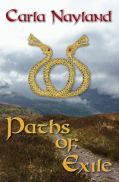Within the Hollow Crown, by Margaret Campbell Barnes. Book review
First published 1948. Edition reviewed, Sourcebooks 2010, ISBN 978-1402239212, 333 pages, uncorrected advance review copy kindly supplied by publisher.
Set in 1381 to 1400, Within the Hollow Crown tells the story of Richard II from the Peasants’ Revolt to the end of his reign. All the main characters are historical figures, including Richard II, his beloved queen Anne of Bohemia, his mother Joan “the Fair Maid of Kent”, his uncles, advisors and counsellors, his cousin Henry Bolingbroke (later Henry IV), his favourite Robert de Vere and the writer Geoffrey Chaucer.
Richard II came to the throne at the age of about ten, owing to the untimely death of his father Edward “The Black Prince”, and real power is in the hands of his uncles and counsellors. When the unprecedented Peasants’ Revolt brings England to the brink of revolution, the fourteen-year-old Richard gets his first taste of responsibility and success. Later, buoyed by the perfect love he finds with his wife Anne of Bohemia, Richard defies his council and takes power into his own hands, developing one of the most glittering and cultured courts in Europe. But in the wake of a devastating loss, Richard allows the shadows of old hatreds to grow in his heart, as much a threat to his crown as any of his enemies.
Like his later namesake Richard III, Richard II has had a bad press. He has a reputation for tyranny and for ratting on the promises he made to defuse the Peasants’ Revolt. Within the Hollow Crown appears to be aiming to redress the balance by giving a pro-Richard portrayal. Handsome, glamorous, intelligent, imaginative, courteous, sensitive and cultured, the Richard II in these pages is an attractive character. Not entirely without flaws, although the reader has to be alert to pick up small clues. Most of the novel is told from Richard’s viewpoint and his enemies, not unnaturally, tend to get an unsympathetic portrayal.
For example, Richard seems to be almost as unlucky in his choice of favourites as his great-grandfather Edward II (whose grisly fate is used in the novel to terrify the sensitive adolescent Richard), but as the reader only sees his tinselly favourite Robert de Vere through Richard’s eyes, there’s little to suggest that other people might have good reason to dislike the relationship until Richard himself is forced to recognise reality. Similarly, Richard regards his opulent, cultured court as the way things should be and those who complain about his extravagance as penny-pinching boors. Only one brief line from a wise advisor hints that Richard’s expenditure might actually give just cause for disquiet. Richard’s emotional vulnerability appeals to the reader’s sympathy, and even when he is callously contemplating murder he justifies it to himself and, by extension, to the reader. Only when Richard recognises himelf momentarily in a verse from one of Geoffrey Chaucer’s poems does the reader get an inkling that Richard’s dictatorial rule may not be quite as benevolent as he thinks it is and that his opponents may have genuine grievances.
I found this focus on Richard’s personal life had both positive and negative effects. On the one hand, it’s a challenge to pick up the tiny hints of trouble ahead, and the reader gets almost the same shock as Richard when situations start to unravel. On the other, Richard’s political opponents appear as crude, obstructive, destructive and/or thick, and I doubt that the situation was quite as one-sided as that. I would have liked to see more of the other side of the story.
Richard dominates the novel so completely that everyone else fades into obscurity by comparison. Of the other characters, the charming lightweight Robert de Vere, the gruff pirate knight Edward Dalyngrygge, his sultry wife Lizbeth, and Richard’s old nurse, the enigmatic Mundina Danos, were the most strongly drawn. I admit I don’t quite see the significance of the subplot involving Lizbeth’s attempts to get Richard into bed. Mundina, on the other hand, is at the centre of a subplot that hinges on the medieval beliefs in damnation and redemption after death. I have no idea whether the events in the subplot are historically accurate, but the motivation is firmly rooted in the time and place, something I always admire in historical fiction.
Richard is sensitive to beauty in all its forms, and this is reflected in the graceful prose, especially the descriptive passages. The idyllic romance between Richard and his beloved wife Anne of Bohemia is a lyrical description of perfect love. Perhaps a little too perfect for realism, but that doesn’t detract from its beauty on the page.
A useful family tree at the beginning of the novel helps in keeping track of Richard’s various uncles and cousins and the relative strength of their claims to the throne. The very brief Author’s Note acknowledges that Richard II is a controversial figure and provides a bibliography of books consulted by the author. (How this relates to modern scholarship on Richard II, 60 years after the novel’s original publication, I have no idea).
Intelligently written, sympathetic account of Richard II and his reign.


